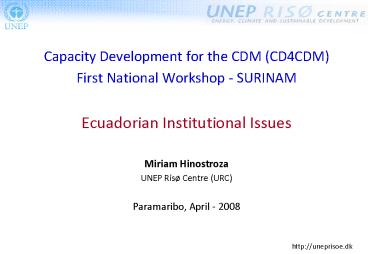Capacity Development for the CDM (CD4CDM) - PowerPoint PPT Presentation
1 / 8
Title:
Capacity Development for the CDM (CD4CDM)
Description:
Capacity Development for the CDM (CD4CDM) First National Workshop - SURINAM Ecuadorian Institutional Issues Miriam Hinostroza UNEP Ris Centre (URC) – PowerPoint PPT presentation
Number of Views:84
Avg rating:3.0/5.0
Title: Capacity Development for the CDM (CD4CDM)
1
- Capacity Development for the CDM (CD4CDM)
- First National Workshop - SURINAM
- Ecuadorian Institutional Issues
- Miriam Hinostroza
- UNEP Risø Centre (URC)
- Paramaribo, April - 2008
2
CDM Institutional Structure - Ecuador
CDM National Authority (DNA) Ministry for
Environment
CDM Promotion Office separate public-private
entity presided by Ministry for Environment
Regulation
Promotion
3
Strengths of the Ecuadorian CDM Institutional
Arrangement
- Separation of regulatory and promotion roles
prevents possible conflicts of interest in the
process of project formulation-project
approval. - Separation of roles enables to better address
development of a heterogeneous range of new
capacities and skills - CDM institutional arrangements have been agreed
upon by the National Climate Change Committee
(NCCC). - The Board of Directors of CDM Promotion Office
includes members from the public, private NGO
sectors. - The Ministry for the Environment is the DNA, but
operates under overall guidance of the NCCC. - DNA and CDM Promotion Office are small technical
units with clear-cut responsibilities.
4
Weaknesses of the Ecuadorian CDM Institutional
Arrangement
- Financial sustainability of CDM entities is not
granted. - Continuity of installed capacities
- DNA officials are not exclusively dedicated to
CDM and still depend on technical assistance
provided by consultants. - CDM Promotion Office officers are consultants
hired by technical cooperation programmes. - Political instability at the M for the E affects
working environment at the CDM Promotion Office
(regardless its public-private nature). - CDM Promotion Office will have to address new
challenges in accordance to evolution of
international emissions market.
5
Project Approval Process in Ecuador
Project Document Project participants DNA
Annex natl requirements based on presentation guide based on evaluation guide
(A) Compliance with applicable legal framework (sector/local scope) Applicable legal prerequisites for proposed project activity. Attachment of relevant licenses, certificates, others. Check on integrality consistency. Consultations with relevant authorizing entities.
(B) Congruence with relevant national/sector/local development policies/plans Explanation on how the proposed project activity is congruent with development policies/strategies. Assessment of evaluators individual briefing and joint recommendation on approval.
(C) Discussion of environmental, socioeconomic and technological impacts (w/o further guidance) Explanation on how positive impacts will be achieved and negative impacts mitigated. Individual briefing and joint recommendation on approval.
Annex intl requirements / /
CDM Project Design Document (PDD as defined by the CDM-EB) Submission of PDD that has been or will be submitted for validation by OE. Review of PDD. Relevant observations may require joint revisions with participants validators.
6
Project Approval Process
7
Approval Process Strengths
- Cost-efficiency
- Evaluation fee expected to be symbolic
- Time-efficiency
- The approval process is designed to be a
streamlined process which takes place in less
than 20 working days - Submission of PDD is requested
- Project participants and DNA will benefit of
dealing with a consolidated project proposal.
8
Approval Process weaknesses
- Assumption legal framework development
plans are congruent with national sustainable
development objectives - Current evaluation criteria is based on that
assumption. - Lack of project-specific SD assessment of
proposed project activity































